► Porsche’s new, electric Macan officially launched
► 4 and Turbo versions revealed, up to 383-mile range
► Prices start from £69,800 for a Macan 4
Porsche’s all-new, electric Macan could well be the most important EV of 2024. After a long development period fraught with delays, the covers have finally come off.
While it might follow the trail blazed by the Taycan in 2019, the new Macan must replace a petrol-only predecessor whose circa-90,000 units per year came an extremely close second to the Cayenne in 2023.
This is our full, official story on Porsche’s first all-electric SUV – a new model that will have to hit the ground running when it goes on sale later in 2024.
Electric Porsche Macan: design and interior
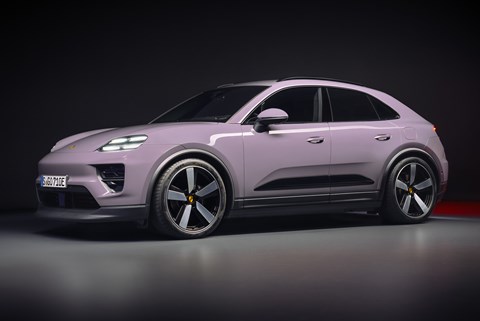
A family resemblance eases the abrupt transition from an incumbent that doesn’t even offer mild hybridisation to a full EV future, but only inconsequential clips and fixings are shared between the two.
Despite the family look, dimensions are quite different between generations. Most significant is a total length stretched some 100mm to 4784mm, with the wheelbase some 86mm longer, but the new car is also 15mm wider and just 2mm lower. Fitted with the 22-inch alloys (20s are the minimum) Porsche has spec’d on the cars we’re poking around in a Stuttgart studio, it’s a longer, sleeker, more muscular look than before.
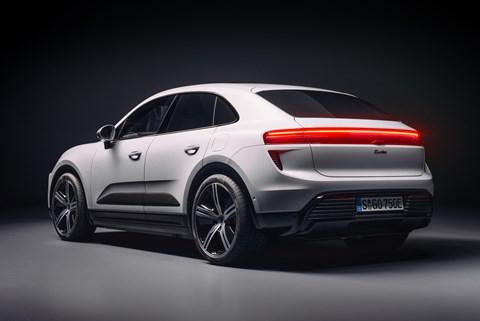
Frameless door glass, a more pronounced coupe profile and various active-aero devices (rear spoiler, front cooling flaps, flexible covers on a fully sealed underbody) all help drop the coefficient of drag to an elbows-in, head-below-handlebars 0.25Cd.
Naturally a larger body and more space-efficient EV powertrain affords more interior space than before – six-feet tall passengers have just enough kneeroom to perch behind a similarly tall driver, as well as surprisingly generous headroom given the aggressively raked roofline.

Luggage storage also increases, from today’s 497 to 540 litres in the case of the Macan 4 with the rear seats in their most upright position – the Turbo offers a little less due to its Bose subwoofer that goes all the way up to anti-social. In both cases there’s a further 84 litres of storage in the ‘froot.’
Given the 570kg battery under the floor, it’s surprising to learn occupants can sit some 28mm lower in the front, and 15mm lower in the rear than the previous Macan – gains reaped from attention-to-detail on the seat bases.
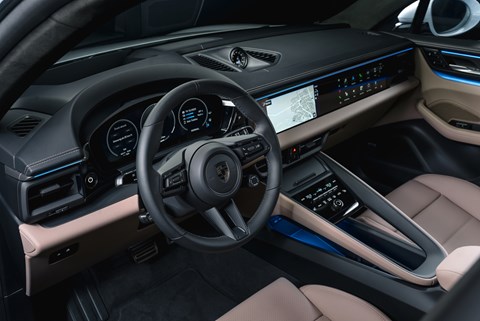
Like the exterior design, the ‘Porsche Driver Experience’ cockpit is similarly familiar. Clearly inspired by the Taycan’s layout and operating logic, PDE debuted last year in the facelifted Cayenne with a new Android Operating System.
A 12.6-inch curved instrument binnacle is shared between the two SUVs, and can switch from a digital representation of Porsche’s classic analogue dials to more modern layouts, while the touchscreen central display is proportionally smaller at 10.9 inches. An additional 10.9-inch screen is optional for front-seat passengers.
Thankfully climate-control functions are still controlled via a physical interface that’s easy to feel out on the move, and route planning contains easily accessed info on the charging points you’ll encounter along the way, including charging speeds, occupancy and payment methods – a decade of connected services keeps you up-to-date too.
Electric Porsche Macan: specs and performance
The new Macan moves away from the clean-sheet J1 architecture developed for Taycan and – unlike bet–hedging BMW and the collective Stellantis brands – leaves no provision for internal-combustion derivatives spun from the same building blocks.
Instead, a new PPE (Premium Platform Electric) platform co-developed with Audi lays foundations for the Macan, Audi Q6 e-tron and Porsche’s plan that more than 80 per cent of sales will be zero emissions by 2030. Some markets, not including the UK due to cybersecurity issues, will continue parallel sales of the existing Macan, probably for two or three more years.

Two Macan variants – the 4 and the Turbo – are confirmed for launch, both with one permanently excited synchronous e-motor per axle (the rear beefier and able to provide either most – the 4 – or all – the Turbo – of total system power in extreme situations). There is also a single-speed transmission rather than the Taycan’s two speeder.
Neither variant lacks go. The 4 is good for 402bhp (only a little below the current range-topping Macan GTS), with a 0-62mph time of 5.2 seconds and 138mph flat out. The Turbo, meanwhile, benefits from 630bhp, a 3.3 0-62mph time and 163mph top speed.
That leaves plenty of room for other derivatives in between, plus insiders draw our attention to the presence of a ‘4’ on the entry-level badge, leaving us to imagine a rear-drive 2 with a little extra range positioned below it.
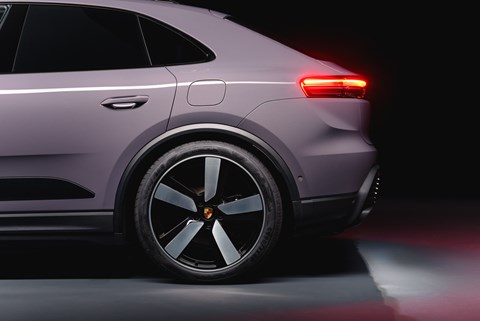
In all cases, a 100kWh lithium-ion battery (of which 95kWh is useable) nestles between the axles, with 12 individually replaceable modules providing a maximum 383-mile range in the 4 – better than not only the max figures for the rather disappointing Taycan (316 miles) but also the Tesla Model Y (331 miles) and BMW’s iX3 (285 miles) and iX (up to 349 miles).
Electric Porsche Macan: technology and charging
Battery construction and power electronics are comparable to the Taycan, including an 800-volt architecture that opens the door to smaller cables for less weight, better packaging space and shorter charge times. With all your charging stars aligned, the Macan can charge at up to 270kW, enough for a 10-80 per cent battery boost in 21 minutes.
Rather than the Taycan’s more costly and bulkier charging booster, however, the Macan deploys ‘bank charging’, so when a charging station uses 400-volt technology, bank charging effectively tricks the station into thinking it’s charging two 400-volt batteries simultaneously. Charging is faster as a result, with 135kW your max.

Porsche is also keen to point out the battery contributes to a centre of gravity some 140mm lower, if less keen to note a kerbweight that increases by around 300kg compared with its predecessor at 2100-2200kg.
But our test drive of an early prototype tells us brilliance lurks here. It starts with new double-wishbone front suspension and a multi-link rear, with coil springs for the base model rising to full air suspension and two-valve shocks being optional for the 4 and standard for the range-topper.
The Turbo also gets an electronically controlled rear differential (aka Porsche Torque Vectoring Plus) and rear-wheel steering that can turn by up to 5 degrees.
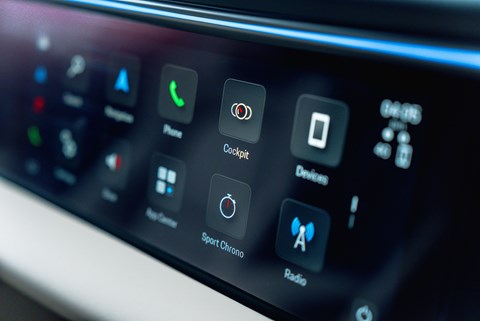
Like the Taycan, all-wheel drive is also fully variable but the new electrical architecture makes response times even faster, responding to slip in just 10ms.
Electric Porsche Macan: prices and on-sale date
Prices start from £69,800 for the Macan 4, with the Macan Turbo coming in with a £95,000 price tag before options with sales starting soon. More variants will launch in the years to come.
When the new Macan launches, Porsche will stand alone among premium rivals in switching a core petrol model wholesale to zero emissions, and even continuing sales of the existing Macan will be on borrowed time. But if the new e-SUV unites the best of Taycan and Macan as our early test drive suggests, Porsche will surely be onto a winner.